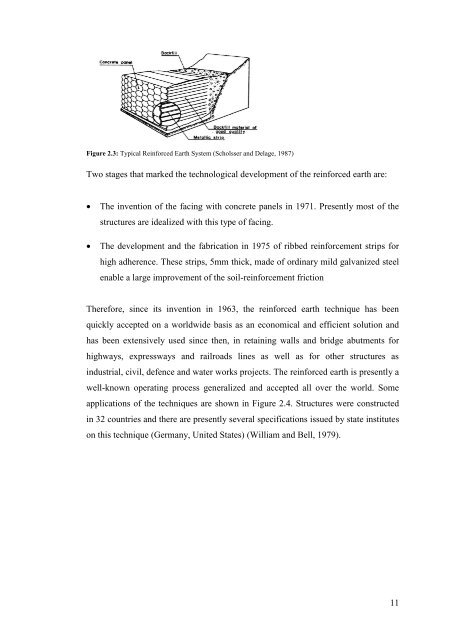Parametric Studies on the Behaviour of Reinforced Soil Retaining
Parametric Studies on the Behaviour of Reinforced Soil Retaining
Parametric Studies on the Behaviour of Reinforced Soil Retaining
You also want an ePaper? Increase the reach of your titles
YUMPU automatically turns print PDFs into web optimized ePapers that Google loves.
Figure 2.3: Typical <strong>Reinforced</strong> Earth System (Scholsser and Delage, 1987)<br />
Two stages that marked <strong>the</strong> technological development <strong>of</strong> <strong>the</strong> reinforced earth are:<br />
The inventi<strong>on</strong> <strong>of</strong> <strong>the</strong> facing with c<strong>on</strong>crete panels in 1971. Presently most <strong>of</strong> <strong>the</strong><br />
structures are idealized with this type <strong>of</strong> facing.<br />
The development and <strong>the</strong> fabricati<strong>on</strong> in 1975 <strong>of</strong> ribbed reinforcement strips for<br />
high adherence. These strips, 5mm thick, made <strong>of</strong> ordinary mild galvanized steel<br />
enable a large improvement <strong>of</strong> <strong>the</strong> soil-reinforcement fricti<strong>on</strong><br />
Therefore, since its inventi<strong>on</strong> in 1963, <strong>the</strong> reinforced earth technique has been<br />
quickly accepted <strong>on</strong> a worldwide basis as an ec<strong>on</strong>omical and efficient soluti<strong>on</strong> and<br />
has been extensively used since <strong>the</strong>n, in retaining walls and bridge abutments for<br />
highways, expressways and railroads lines as well as for o<strong>the</strong>r structures as<br />
industrial, civil, defence and water works projects. The reinforced earth is presently a<br />
well-known operating process generalized and accepted all over <strong>the</strong> world. Some<br />
applicati<strong>on</strong>s <strong>of</strong> <strong>the</strong> techniques are shown in Figure 2.4. Structures were c<strong>on</strong>structed<br />
in 32 countries and <strong>the</strong>re are presently several specificati<strong>on</strong>s issued by state institutes<br />
<strong>on</strong> this technique (Germany, United States) (William and Bell, 1979).<br />
11

















